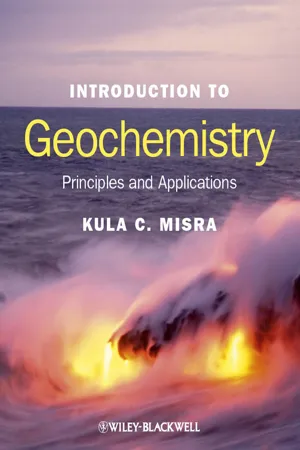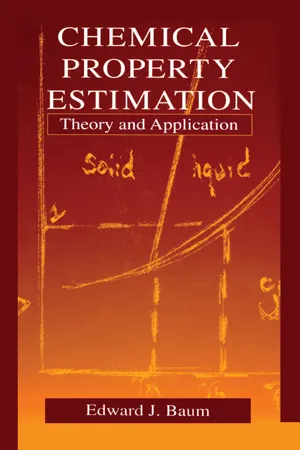Chemistry
Solubility Product Calculations
Solubility product calculations involve determining the equilibrium concentration of ions in a saturated solution, using the solubility product constant (Ksp). This constant is the product of the concentrations of the ions raised to the power of their coefficients in the balanced chemical equation. By using Ksp, one can predict the solubility of a compound and its potential to form a precipitate.
Written by Perlego with AI-assistance
Related key terms
Related key terms
1 of 4
Related key terms
1 of 3
9 Key excerpts on "Solubility Product Calculations"
- eBook - ePub
Introduction to Geochemistry
Principles and Applications
- Kula C. Misra(Author)
- 2012(Publication Date)
- Wiley-Blackwell(Publisher)
sp ), although it actually represents a product of activities:(7.24)Asai=mi γi, substitution for a i in (equation 7.24 ) gives(7.25)For the mineral barite (BaSO4 ), for example,Since dissociation of 1 mole of BaSO4 produces 1 mole of Ca2 +(7.26)If the solution can be assumed to be ideal, solubility ofFor the mineral fluorite (CaF2 ), to consider another example,Let x = solubility of CaF2 (in moles kg− 1 of water). Since the dissociation produces only one-half as many moles of Ca2 + as F− ,Substituting for mF-,(7.27)If the solution can be assumed to be ideal,(7.28)The solubility of a substance is a function of temperature and pressure because the solubility product is an equilibrium constant that varies with temperature and pressure as discussed in section 6.2. For most salts, the solubility product – and, therefore, the solubility – increases with increasing temperature, but the opposite is true for some salts such as calcite and other carbonates. Some salts and some ions in concentrated solutions have activity coefficients greater than unity. This means that as a solution becomes more concentrated, the solubility of a slightly soluble salt may pass through a maximum and then decrease rapidly with further increase in the solute concentration (Krauskopf and Bird, 1995, p. 51). For all gases, solubility decreases as the solution temperature rises. Other major factors affecting solubilities, as will be illustrated by some of the examples below, include ionic strength, pH, and composition of the solution. - eBook - ePub
- Jeffrey Gaffney, Nancy Marley(Authors)
- 2017(Publication Date)
- Elsevier(Publisher)
y is;A aB bs ⇄ aAaq + bx +By –The general expression for the solubility product constant for this dissociation is;(10)K sp=Aax +Bby −(11)Example 12.4: Determining the K sp From Solubility DataCalculate the solubility product constant for lead(II) chloride if 50.0 mL of a saturated solution contains 0.2207 g of lead(II) chloride.1.Write the chemical equation and the K sp expression for the dissolution of lead(II) chloride.Chemical equation: PbCl2 (s) → Pb2 + (aq) + 2Cl− (aq)Solubility product constant: K sp = [Pb2 + ][Cl− ]22.Determine the concentration of PbCl2 .= 7.936 ×0.2207 g278.1 g / mol10mol PbCl– 4= 0.0159 M7.936 ×10mol– 40.050 LPbCl 23. Determine the concentrations of the ions in solution.Since, after dissociation, there are two chloride ions for every lead ion:[Pb2 + ] = 0.159 M[Cl– ] = 2 × 0.159 M = 0.0318 M4.Calculate the Ksp .K sp = [Pb2 + ][Cl− ]2 = (0.159)(0.038)2 = 1.61 × 10− 5Since the solubility product constant is an equilibrium constant of a dissolution reaction, a solubility product quotient (Q sp ), similar to the reaction quotient described in Section 7.5 , would be the value of the expression for the K sp in Eq. (11) with concentrations at any point in the reaction. If the product of the ionic concentrations in Eq. (11) - eBook - ePub
Environmental Engineering
Principles and Practice
- Richard O. Mines(Author)
- 2014(Publication Date)
- Wiley-Blackwell(Publisher)
2.7 Solubility (solubility product) So far, we have dealt with aqueous solutions in which the chemical species are highly soluble. In this section, our focus will be on liquid-solid species that are partially soluble or insoluble. All solids, no matter how seemingly insoluble, are soluble to some degree. When a solid is placed in water, the ions at the surface of the solid will migrate into the water. This is called dissolution. Simultaneously, ions in the solution will be redeposited on the surface of the solid; this is known as precipitation. Equilibrium will be reached between the crystals of the compound in the solid state and its ions in solution. In general, the solubility of most compounds increases with increasing temperature. Snoeyink & Jenkins (1980, page 251) indicate that the solubilities of and do not increase as temperature increases. Equation (2.112) shows the general equation of a solid compound dissolving in pure water to form its constituent ions. 2.112 The equilibrium expression is written as follows: 2.113 As described by Sawyer & McCarty (1994, page 37), at equilibrium or saturation, the surface area of the solid is the only portion that is in equilibrium with the ions in solution. Therefore, the concentration of solid as represented by in the denominator of Equation (2.113) can be considered a constant in equilibrium solubility problems. Equation (2.114) is rewritten to show the development of the solubility-product constant, 2.114 2.115 When the solution is saturated or at equilibrium. When the solution is under-saturated and no solids species are present. When the solution is super-saturated and solid species are being formed. The solubility-product constants for several solids of significance in environmental engineering are presented in Table 2.16. Partially soluble salts have small values, while soluble salts have relatively large values - eBook - ePub
Rapid Review of Chemistry for the Life Sciences and Engineering
With Select Applications
- Armen S. Casparian, Gergely Sirokman, Ann Omollo(Authors)
- 2021(Publication Date)
- CRC Press(Publisher)
ppm).4.12 Definition of Solubility Product Constant K
spConsider, for example, the slightly soluble salt CaF2 (s) in equilibrium with water. Its limited dissociation and ionization in water can be expressed as follows:(4.9)CaF 2( s )⇌Ca2 +( aq )+ 2F −( aq )And its solubility product constant,Ksp, as(4.10)K=s p[Ca]2 +[2F −]Note that [CaF2 (s)] does not appear in the Ksp expression since it represents the undissolved portion, and it is pure solid. It has no concentration.Also note that [Ca2+ ] represents the concentration of Ca2+ ion dissolved in water, while [F− ] represents the F− ion concentration dissolved in water.Note also that when a given amount of CaF2 (s) is dissolved in a known amount of water:[= 2]Ca2 +( aq )[=]F −( aq )[]CaF 2( aq )where CaF2 (aq) is the portion that is dissolved in water. In other words, whatever the proportion of CaF2 (s) that dissolves in water, the same molar concentration is present as Ca2+ (aq) ion, but twice that molar concentration is present as F− (aq) ion.The smaller the Ksp value, the lower the solubility of the salt. It follows that the Ksp value of a salt can be calculated by determining the solubility of each ion and then using Equation 4.10.4.13 Calculating the Molar Solubility from K
spThe molar solubility of any slightly soluble salt, along with the concentration of any of its ions, can be calculated from its Ksp value. The formula of the salt must be known, however, so that its dissociation and ionization can be written.It is important to note that simply comparing the Ksp - No longer available |Learn more
MCAT General Chemistry Review 2024-2025
Online + Book
- (Author)
- 2023(Publication Date)
- Kaplan Test Prep(Publisher)
bends). The condition is painful and dangerous and can be fatal if not properly treated.As solute dissolves into the solvent, the system approaches saturation, at which point no more solute can be dissolved and any excess will precipitate to the bottom of the container. We may not know whether the solution has reached saturation, and so to determine where the system is with respect to the equilibrium position, we can calculate a value called the ion product (IP), which is analogous to the reaction quotient, Q, for other chemical reactions. The ion product equation has the same form as the equation for the solubility product constant:IP = [An+]m[Bm–]nEquation 9.7The difference is that the concentrations used in the ion product equation are the concentrations of the ionic constituents at that given moment in time, which may differ from equilibrium concentrations. As with the reaction quotient Q, the utility of the ion product lies in comparing its value to that attained at equilibrium, Ksp . Each salt has its own distinct Ksp at a given temperature. If, at a given set of conditions, a salt’s IP is less than the salt’s Ksp , then the solution is not yet at equilibrium and is considered unsaturated. For unsaturated solutions, dissolution is thermodynamically favored over precipitation. If the IP is greater than the Ksp , then the solution is beyond equilibrium, and the solution is considered supersaturated. It is possible to create a supersaturated solution by dissolving solute into a hot solvent and then slowly cooling the solution. A supersaturated solution is thermodynamically unstable, and any disturbance to the solution, such as the addition of more solid solute or other solid particles, or further cooling of the solution, will cause spontaneous precipitation of the excess dissolved solute. If the calculated IP is equal to the known Ksp , then the solution is at equilibrium—the rates of dissolution and precipitation are equal—and the solution is considered saturated. The molarity of a solute in a saturated solution is called the molar solubility - eBook - ePub
- Detlev Möller(Author)
- 2015(Publication Date)
- De Gruyter(Publisher)
solvation , i.e. the dissolved molecule becomes surrounded by solvent molecules:The index (aq) also often includes that the species is hydrated (solvated by H2 O). Additionally, the solubility can be increased by complexation (see Chapter 3.2.2.7). Solubility quantifies the dynamic equilibrium state (Equation (3.64) ) achieved when the rate of dissolution equals the rate of precipitation . The solubility depends on temperature. It can be derived in a similar equation as for evaporation (Equation (3.50) ) where solvation enthalpy for indefinite dilution:If the saturation concentration is exceeded (for example by changing T and pH), the solute precipitates and forms a solid precipitate (or sediment ). Salts dissociate (the charge is here not important for describing the solubility and therefore not regarded, see Equation (3.44) ):The equilibrium is described by (see Chapter 3.2.2.1):The term [AB]s denotes the concentration of AB in the pure substance AB and is therefore constant (e.g. dimension in mol per litre or kilogram). We define a solubility product constant K sp and can write:K sp = [A]α [B]β = K diss [Aα Bβ ] . (3.68)The T dependency in the case of electrolytes is now given by (see Equation (3.56) ):Note that in Equation (3.67) and Equation (3.68) instead of concentration c , activity a (see Chapter 3.1.2.4) must be used more exactly. However, in the case of diluted solutions and difficultly soluble substances (e.g. SiO2 , CaCO3 - eBook - ePub
Chemical Property Estimation
Theory and Application
- Edward Baum(Author)
- 2018(Publication Date)
- CRC Press(Publisher)
CHAPTER 7 Aqueous Solubility and Activity Coefficient 7.1 INTRODUCTIONThis chapter describes methods of estimating the solubility and activity coefficient of liquid and solid hydrophobic chemicals in water, primarily. The solubility of gases is discussed in more detail in Chapter 8.A saturated solution is a solution of a chemical solute that is in equilibrium with the pure undissolved chemical. The solubility is the concentration of solute in a saturated solution. Aqueous solubility,C W S, is commonly expressed either in terms of solute molarity (mol solute/L solution), mass concentration (g solute/L solution), or mass ratio (g solute/kg solvent). Occasionally, it is expressed in terms of solute molality (mol solute/kg solvent), mole percent (mol solute/100 mol solution), or mole fraction (mol solute/mol solution). In addition, solubility is often expressed in semiquantitative terms such as miscible or infinitely soluble(, soluble)C W S= ∞(, moderately soluble (0.1 mol/L >)C W S> 0.1mol / LC W S> 0.01 mol/L), and insoluble (). Many organic chemicals are said to be sparingly soluble in water (C W S< 0.01mol / L).C W S≤ 1g / LPlenty of data are available on the aqueous solubility of organic chemicals, but, unfortunately, much of it is semiquantitative. Some useful collections of quantitative values are published by IUPAC (1987), Howard (1989), Mackay et al. (1995), Penning et al. (1990), Verschueren (1983), and Yalkowsky and Dannenfelser (1990). The solubility of a chemical is usually measured in air-saturated distilled water and reported for a defined temperature. The range of solubility of organic chemicals in air-saturated water at 20°C extends from infinitely soluble (completely miscible) to below 1 × 10−12 mol/L.Aqueous solubility determines, in large measure, the speed with which chemicals travel and biodegrade in the environment. It is an important control of the partitioning of chemicals between air, water, soil, and biota (see Chapters 8 , 10 , and 11 - eBook - ePub
Chemistry
Concepts and Problems, A Self-Teaching Guide
- Richard Post, Chad Snyder, Clifford C. Houk(Authors)
- 2020(Publication Date)
- Jossey-Bass(Publisher)
For practical purposes in some experiments, we can often ignore the dissolved portion of a very slightly soluble salt. For K sp calculations and the common ion effect, we cannot ignore it.) The value of the solubility product constant (K sp) can easily be determined if the solubility of a salt is known. Lead sulfide (PbS) is a slightly soluble salt. Only 1 × 10 −14 mol of the salt will dissolve in a liter of water at 20 °C. In pure water, at 20 °C, this means that the concentration of Pb 2+ ion will be 1 × 10 −14 mol/liter and the concentration of S 2− ion will also be 1 × 10 −14 mol/liter. Calculate K sp K sp = [Pb 2+ ][S 2− ] = ____________ Answer: (1 × 10 −14 mol/liter)(1 × 10 −14 mol/liter) = 1 × 10 −28 mol 2 /liter 2 Up to 7 × 10 −5 mol of calcium carbonate will dissolve in a liter of pure water at 20°C. Calculate the K sp of CaCO 3 at 20°C. K sp = _________________ Answer: [Ca 2+ ][CO 3 2− ] = (7 × 10 −5 mol/liter)(7 × 10 −5 mol/liter) = 4.9 × 10 −9 mol 2 /liter 2 At a certain temperature, up to 2 × 10 −4 mol of CaF 2 will dissolve in a liter of pure water. Calculate the K sp of CaF 2 at that temperature. (Note: The fluoride ion has a coefficient of 2 in front of it. This means that two fluoride ions are produced for every calcium ion when CaF 2 dissociates. It also means that the fluoride ion concentration must be squared in the K sp expression.) K sp = _________________ Answer: [Ca 2+ ] = 2 × 10 −4 mol/liter Two fluoride ions are formed for every calcium ion. All of the K sp solubilities calculated in the examples assume that the salts are dissolved in pure water (with no common ions present) - No longer available |Learn more
- Neil D. Jespersen, Pamela Kerrigan(Authors)
- 2023(Publication Date)
- Barrons Educational Services(Publisher)
M solution). Saturated solutions of insoluble salts have concentrations that are less than 0.1 molar. However, most insoluble salts do dissolve to a small extent.The solution process may be written in a form similar to a chemical reaction. For solid Fe2 (OH)3 we haveFe(OH)3 (s) ⇌ Fe3+ (aq) + 3OH− (aq)The equilibrium expression for this is written asKc= [Fe3+ ][OH− ]3In the special case of the solubility of slightly soluble compounds, the equilibrium expression always represents the product of the ions produced when the compound dissolves. The equilibrium constant is called the solubility product constant and is given the symbol Ksp :Ksp= [Fe3+ ][OH− ]3Fe(OH)3 (s) does not appear in the equilibrium expression because it is a solid. However, in the equilibrium table, we should note in the column for the solid that initially we start with some solid. Then some small amount of solid, −x, will dissolve. At equilibrium, some solid must be left. This is shown in the next equilibrium table.Questions involving Ksp are solved in the same way as other equilibrium problems. For example, Ksp has a value of 1.6 × 10− 39 for Fe(OH)3 . The molar solubility is calculated by setting up an equilibrium table:Entering the information from the EQUILIBRIUM line into the Ksp equilibrium expression givesThe value of x is used to calculate the molar concentrations of Fe3 + and OH− in the solution. We enter these data in the table:The solubility of Fe(OH)3 may be deduced from this table also. The CHANGE line indicates that −x of the compound dissolves, and therefore x represents the solubility of Fe(OH)3 , or 8.8 × 10− 11 mol L− 1 .If Fe(OH)3 is dissolved in a solution that already contains the Fe3 + ion, the common ion effect is observed. The common ion effect is a decrease in the solubility of a compound when it is dissolved in a solution that already contains an ion in common with the salt being dissolved. As an example, we can calculate the solubility of Fe(OH)3 in a solution that already has a 6.5 × 10− 5 M concentration of Fe3
Index pages curate the most relevant extracts from our library of academic textbooks. They’ve been created using an in-house natural language model (NLM), each adding context and meaning to key research topics.
Explore more topic indexes
Explore more topic indexes
1 of 6
Explore more topic indexes
1 of 4








